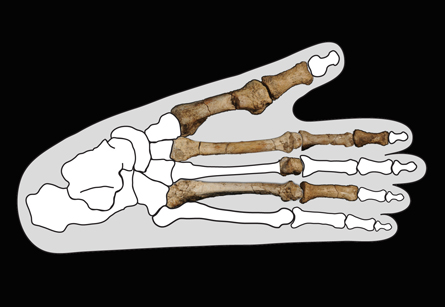Please note: Osher Rainforest will be closed for maintenance Jan. 14–16.
Science News
Fantastic Fossil Foot
April 2, 2012

What can a few fossilized bones indicate? Quite a lot if they happen to belong to a human ancestor that lived 3.4 million years ago, it appears.
Last week, fossilized foot bones stepped into the spotlight by way of a study published in Nature. They appear to belong to a new pre-human species, although more fossils are needed to be sure.
This new species lived around the same time and place as Lucy’s species, Australopithecus afarensis. Unlike Lucy and her kin, however, this other species was not much of a walker. The species was bipedal, but not very agile or quick.
Au. afarensis fossils demonstrate that they were bipedal. In fact, their big toe wasn’t too different from ours. The recently discovered fossil foot, however, had a larger big toe, closer to chimpanzee feet than ours. These pre-humans were more adept at climbing trees than walking.
“This discovery was quite shocking,” says study co-author and project co-leader Bruce Latimer of Case Western Reserve University. “These fossil elements represent bones we’ve never seen before. While the grasping big toe could move from side to side, there was no expansion on top of the joint that would allow for expanded range of movement required for pushing off the ground for upright walking. This individual would have likely had a somewhat awkward gait when on the ground.”
Researchers liken the foot to that of Ardipithecus ramidus (also know as Ardi), which lived 4.4 million years ago. Is the new species a close relative of Ardi? Possibly, says Daniel Lieberman—of Harvard University, who wasn’t involved in the study—in National Geographic:
This looks very much like the same kind of foot, but it's a million years younger, so that lineage of hominins didn't go extinct when the australopithecines evolved—they continued to be there.
(You can read more of Lieberman’s views on this finding in the New York Times and Nature News.)
The fossilized bones were found at a relatively new site, so researchers are hopeful more bones from the species turn up soon.
Image: Y. Haile-Selassie/Cleveland Museum of Natural History